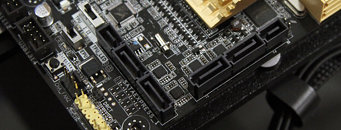Wednesday, April 23rd 2014

ASUS First in the World to Unleash Full SATA Express Performance
ASUS today announced that research and development work supported by Intel has led to the discovery of a BIOS structure that unleashes the true full potential of the latest SATA Express interface standard on future ASUS motherboards. Following the CES 2014 debut of the ASUS Z87-Deluxe/SATA Express concept motherboard, ASUS and Intel continued working together to ensure that users enjoy the full performance of the SATA Express interface and SATA Express components.
The joint research effort means that ASUS is the first motherboard manufacturer in the world to discover and implement a technology that is critical for SATA Express to perform at its best - the Separate Reference Clock with Independent Spread Spectrum Clocking Architecture, or SRIS for short.In order to identify and validate this exciting and valuable breakthrough, ASUS developed Hyper Express, an exclusive 2.5-inch SATA Express external enclosure. This smart invention is a concept device that accommodates two mSATA devices and enabled ASUS engineers to measure extensively SATA Express interface design, allowing us to finely engineer new motherboard designs to unleash the new standard's full speed.
Full-speed SATA Express with SRIS in the BIOS
In order to deliver the full potential of SATA Express, the host motherboard must contain the SRIS architecture in the BIOS. It ensures that the crucial timings between the high-speed SATA Express device and the motherboard are kept precisely in tune. Users of future ASUS motherboards will enjoy sequential read/write speeds of up to 745/809 MB/s - so fast that a 10 GB full-length HD movie transfers in around 10 seconds!
SRIS ensures the best SATA Express compatibility
In addition to unleashing the full speed of SATA Express, the ASUS SRIS breakthrough provides consumers with numerous other advantages.
SATA Express-capable motherboards that lack the SRIS architecture in the BIOS could present compatibility problems. SATA Express devices might not be recognized, for example; or recognized devices might not work correctly. Even in situations where SATA Express devices are recognized and appear to function correctly, their true performance could be hindered by lack of SRIS BIOS implementation.
The discovery and development of SRIS is another world first for ASUS and cements our position as the industry's leading motherboard manufacturer. Our SATA Express solution is the only one to have undergone full SRIS testing and validation to ensure the true potential of the interface is realized - and that means that only buyers of forthcoming ASUS motherboards are assured the very best SATA Express performance.
The SRIS BIOS technology will be available worldwide in future ASUS motherboards.
The joint research effort means that ASUS is the first motherboard manufacturer in the world to discover and implement a technology that is critical for SATA Express to perform at its best - the Separate Reference Clock with Independent Spread Spectrum Clocking Architecture, or SRIS for short.In order to identify and validate this exciting and valuable breakthrough, ASUS developed Hyper Express, an exclusive 2.5-inch SATA Express external enclosure. This smart invention is a concept device that accommodates two mSATA devices and enabled ASUS engineers to measure extensively SATA Express interface design, allowing us to finely engineer new motherboard designs to unleash the new standard's full speed.
Full-speed SATA Express with SRIS in the BIOS
In order to deliver the full potential of SATA Express, the host motherboard must contain the SRIS architecture in the BIOS. It ensures that the crucial timings between the high-speed SATA Express device and the motherboard are kept precisely in tune. Users of future ASUS motherboards will enjoy sequential read/write speeds of up to 745/809 MB/s - so fast that a 10 GB full-length HD movie transfers in around 10 seconds!
SRIS ensures the best SATA Express compatibility
In addition to unleashing the full speed of SATA Express, the ASUS SRIS breakthrough provides consumers with numerous other advantages.
SATA Express-capable motherboards that lack the SRIS architecture in the BIOS could present compatibility problems. SATA Express devices might not be recognized, for example; or recognized devices might not work correctly. Even in situations where SATA Express devices are recognized and appear to function correctly, their true performance could be hindered by lack of SRIS BIOS implementation.
The discovery and development of SRIS is another world first for ASUS and cements our position as the industry's leading motherboard manufacturer. Our SATA Express solution is the only one to have undergone full SRIS testing and validation to ensure the true potential of the interface is realized - and that means that only buyers of forthcoming ASUS motherboards are assured the very best SATA Express performance.
The SRIS BIOS technology will be available worldwide in future ASUS motherboards.

22 Comments on ASUS First in the World to Unleash Full SATA Express Performance
Also LOL @ "discover". You "discovered" BIOS code? Really, do tell me more.
And I hope they will include that Sata -> Sata Express adaptor they had in the demo for Z87-Deluxe video.
I have always been negative regarding SATA express. Native PCIe SSDs are a much better choice if you need the extra bandwidth. Sandforce's upcoming SF-3700 SSD controller is native PCIe 2.0 x4 but will also be available in SATA Express. The problem is that by using SATA express instead of a PCIe card you are cutting that drive's interface bandwidth in half from 2GB/s to 1GB/s.
www.lsi.com/downloads/Public/Flash Storage Processors/LSI-PB-SF3700-Family.pdf
It won't support PCIe 3.0 and it gets maximum bandwidth from an x4 slot, which neither SATA Express nor M.2 provide.It's possible that PCIe 3.0 could be done using current cables. However, I don't see how the width could be expanded to x4 without a change of connector.
Edit: I found the Anandtech article to which you are referring. The article refers to PCIe 2.0 x2 (SATA Express) having a maximum real-world bandwidth of ~780MB/s compared to ~515MB/s for SATA 6Gb/s. The article does state that PCIe 3.0 is supported on SATA express, but considering all of these SATA express motherboards are connected via PCIe 2.0 to the southbridge, that will diminish the usefulness of SATA Express. You would have to steal lanes from graphics to use PCIe 3.0, and I'm not sure how many motherboard manufacturers will do that.
tvtropes.org/pmwiki/pmwiki.php/Main/FlatWhat
I don't know about you, but if reviewers test it out and its as advertised in terms of speed, IMO this is a welcomed addition.
:)
Still such motherboards won't come cheaply and may start at ~$300+ USD as an entry level and maybe even more like ~$350 or ~$400.
It's not so bad if a manufacturer puts out just the right board. Like I paid $280 for my Lian-Li case, but I've used it for some five years now.
However, a lot of people will look to pay less in their build (or distribute their funds differently) and as such will historically avoid more expensive platforms like X79 / C600 / LGA2011. That history may very well be consistent with the upcoming X99 / LGA2011-3 platform. In fact, with all else being equal, X99 / LGA2011-3 may work out to be slightly more expensive due to the introduction of DDR4.
So while you and I might build X99 / LGA2011-3 platforms others will avoid it like the plague and they wont suffer performance wise in a lot of cases for doing so either (depending on their use case).